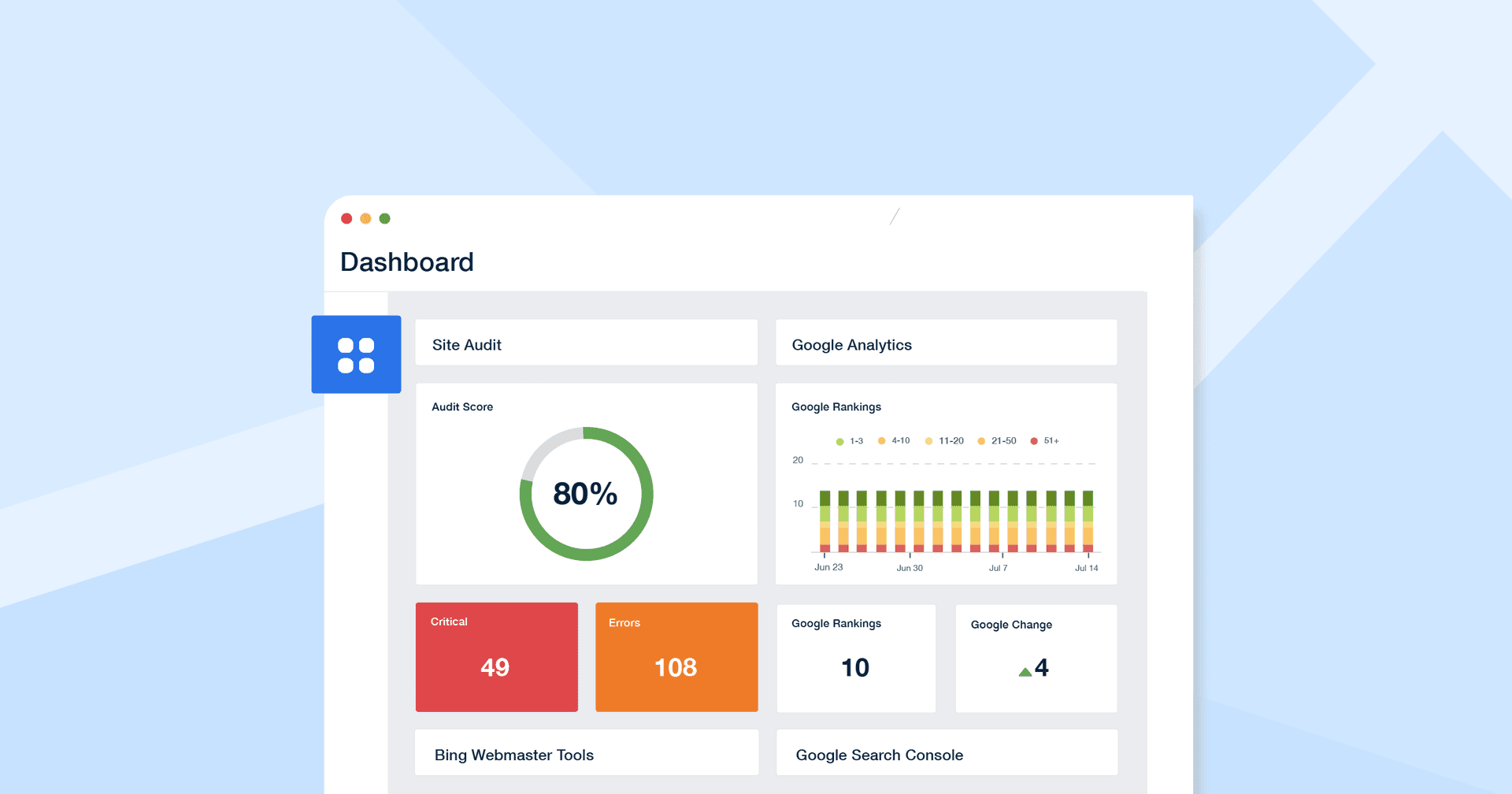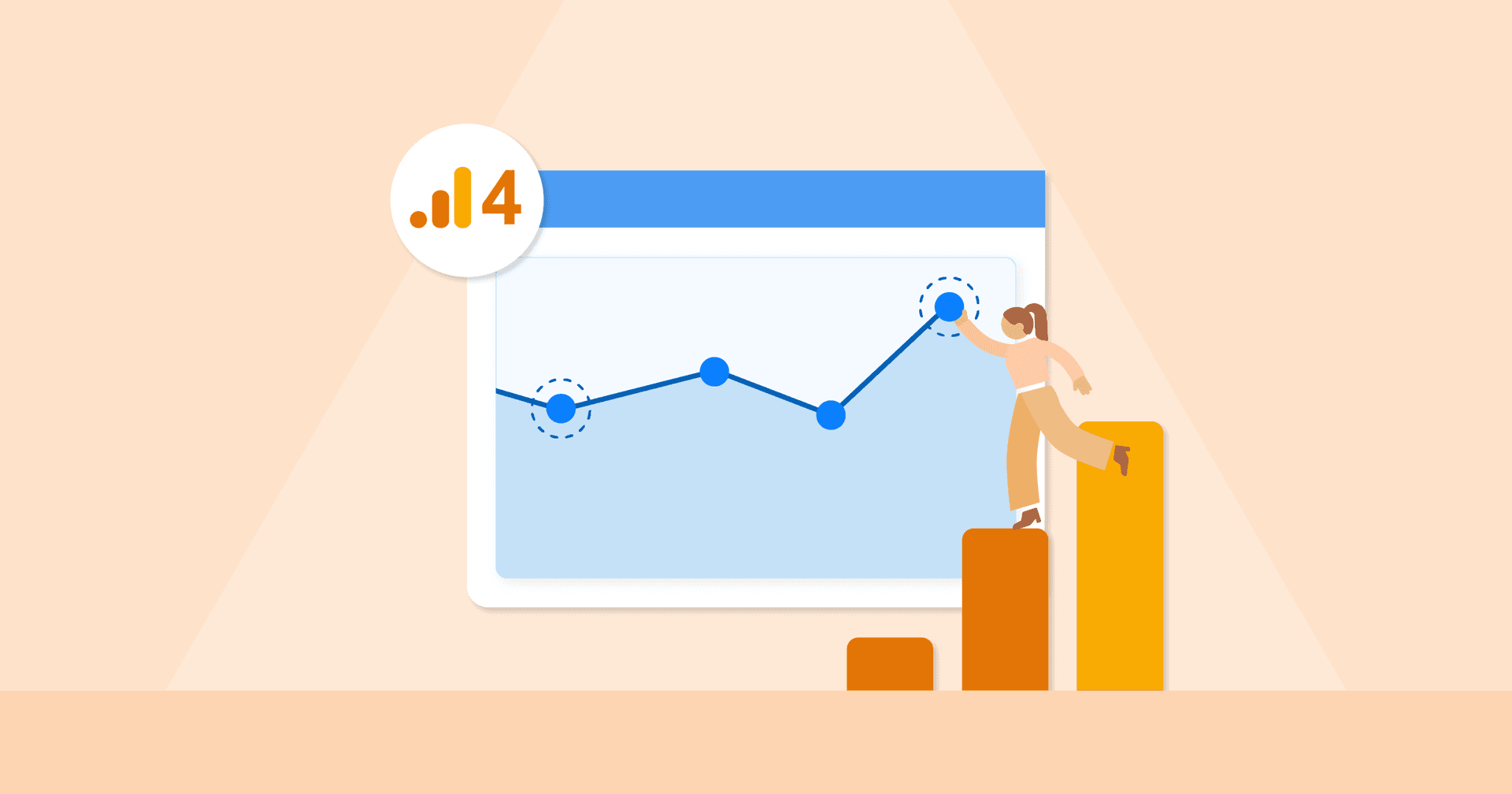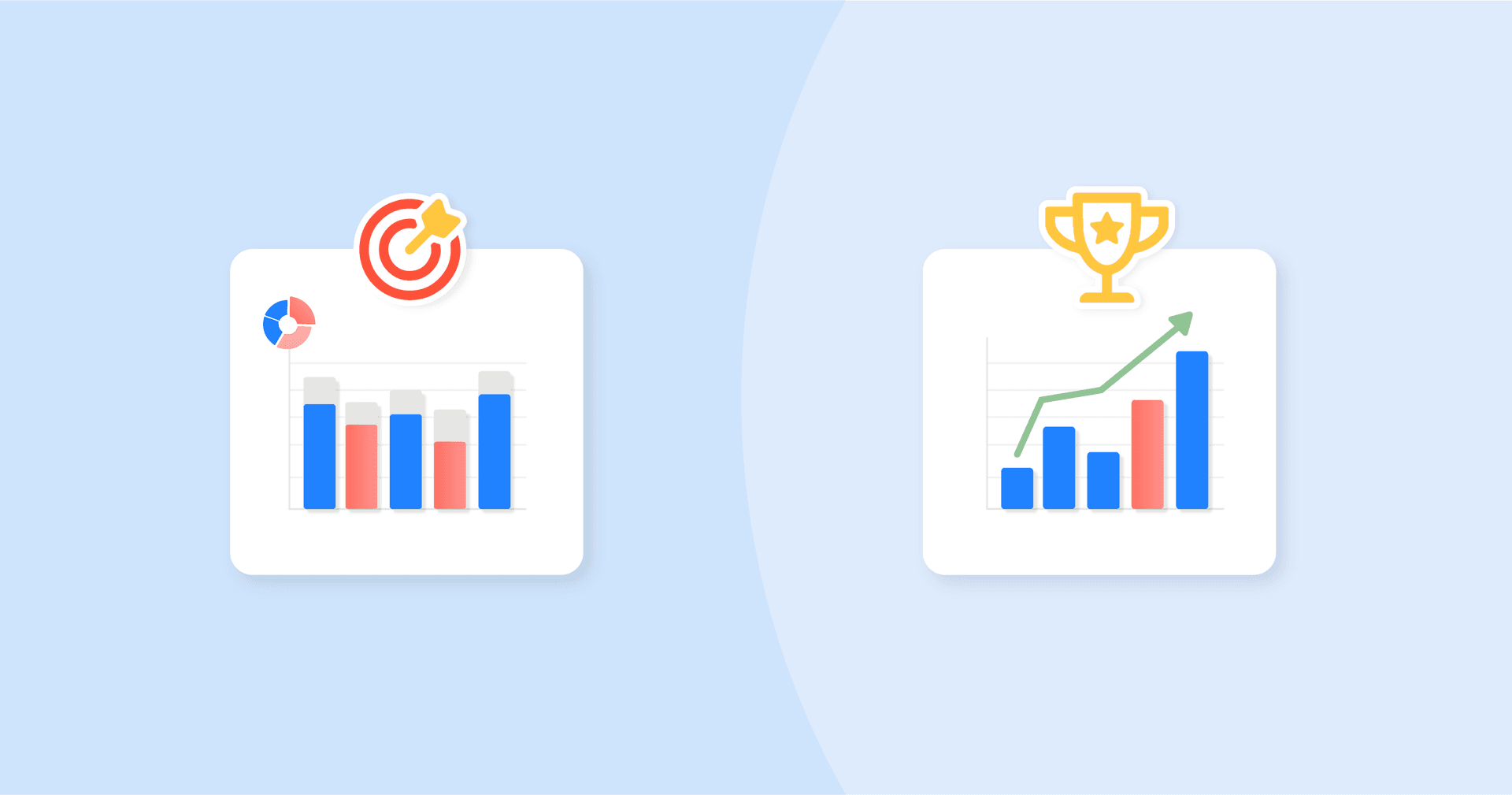Table of Contents
QUICK SUMMARY:
Marketing agencies track website KPIs to measure a website's effectiveness in achieving a client’s business objectives. This strategy provides actionable insights into areas like user engagement and conversion rates. In this article, we share 18 essential website KPIs to optimize strategies, demonstrate value to clients, and drive long-term growth.
Website KPIs are important tools for marketing agencies that want to deliver measurable results for their clients. These key performance indicators provide a clear view of how well a website is meeting its business goals, offering insights into user engagement, conversion rates, and more.
For agencies, understanding and using website KPIs must go beyond simply tracking data. Keeping tabs on these KPIs is all about refining strategies, improving client campaigns, and standing out from the competition.
Take bounce rate, for example—a KPI that measures the percentage of visitors who leave a site after viewing just one page. A high bounce rate typically means that the content on a landing page isn’t connecting with the audience, prompting the need for immediate changes.
Agencies that spot and address these issues show their value to clients by making data-driven decisions that lead to better outcomes.
Tracking and using website KPIs improves an agency’s marketing strategies and builds stronger, more trusting relationships with clients. This sets the agency apart from competitors who might not be as precise or detailed in their methods.
What Are Website KPIs?
We all know what a Key Performance Indicator (KPI) is, but in case you need a refresher on what website KPIs are, we’ve got you.
Simply put, a website key performance indicator is a specific metric that gauges a website's effectiveness in achieving a client’s business goals. Tracking the top website KPIs is important for marketing agencies for many reasons.
First, they provide a quantifiable measure of how well marketing strategies are performing. Agencies analyze these metrics to identify what's working and what needs adjustment, allowing for data-driven decision-making.
Second, KPIs offer a way to communicate value to clients. Agencies use KPIs to demonstrate the impact of their efforts, whether it's increasing traffic, improving conversion rates, or generating leads. This transparency helps build trust, as clients can clearly see evidence of the return on their investment.
Agency Tip: Do you have a client who constantly emails you asking for updates on their marketing campaigns? Within the AgencyAnalytics platform, marketing agencies give their clients specific user permissions to their own dashboards to stay up-to-date on marketing activities 24/7.
Marketing agencies also use KPIs to set realistic goals and expectations. By understanding these metrics, agencies guide clients in setting achievable objectives and measuring progress. This alignment ensures that both parties are focused on the same outcomes, which is essential for retaining clients in the long run.
Read More: 4 Signs Your Agency Client is About To Churn (and How to Re-Engage Them)

Image: An example of a KPI report
In short, website KPIs help agencies fine-tune their strategies, justify their actions, and maintain strong, transparent client relationships. Consistently tracking these metrics is key to driving sustained agency growth and proving the value of the agency's work.
Top 18 Website KPIs Marketing Agencies Should Track
There are many website KPIs that agencies need to keep an eye on to ensure success. We've put together a list of 18 key metrics that every marketing agency should track to help their clients' websites perform at their best.
1. Organic Search Traffic
What Is Organic Search Traffic?
Organic search traffic refers to site visitors who land on a website after performing a search on a search engine like Google, without clicking on paid advertisements. This type of traffic is driven by the website's visibility in search engine results pages (SERPs) and is influenced by the site's SEO efforts.
How To Calculate Organic Search Traffic
This data is typically found in web analytics tools like Google Analytics, under the “Acquisition” or “Traffic Sources” sections.
Why Does Organic Search Traffic Matter to Agencies?
Organic search traffic is important to agencies because it reflects the success of a website’s SEO strategy. High organic traffic indicates that the site is ranking well for relevant keywords, leading to more visibility and potentially higher conversions. It’s a cost-effective way to drive sustained traffic, making it a key metric in evaluating the effectiveness of marketing initiatives.
2. Keyword Rankings
What Are Keyword Rankings?
Keyword rankings refer to the position of a website’s pages in search engine results for specific keywords or phrases. These rankings determine how easily users find the website when searching for relevant terms.
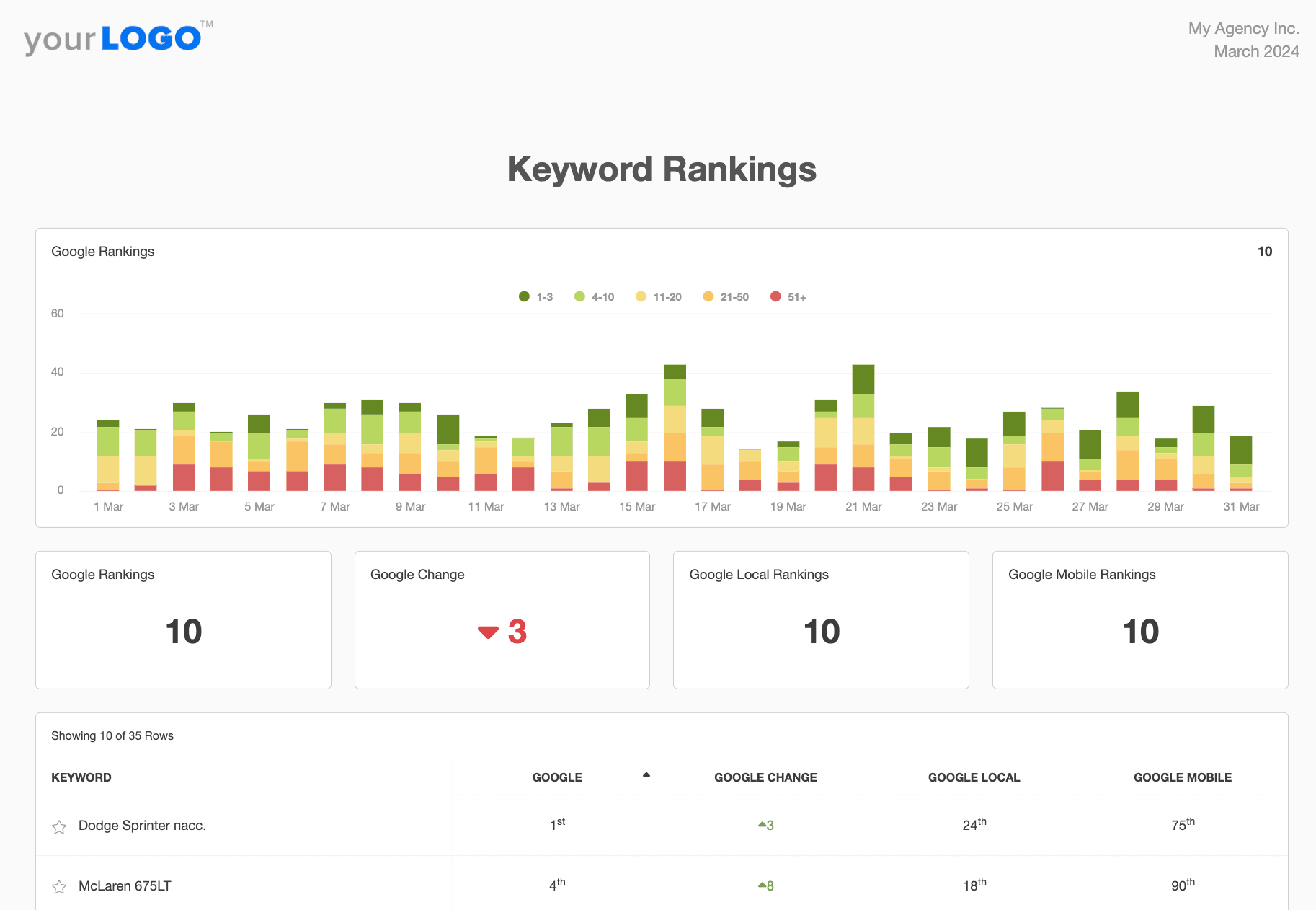
How To Calculate Keyword Rankings
Keyword rankings are tracked by monitoring the position of a website’s pages for targeted keywords in search engine results pages (SERPs). This is done using various SEO agency software, such as the AgencyAnalytics Rank Tracker, Semrush, Ahrefs, or Google Search Console, which provide insights into where a site ranks for specific search queries over time.
Why Do Keyword Rankings Matter to Agencies?
Keyword rankings are important for agencies because they directly impact a website’s visibility in search engines. Higher rankings for relevant keywords lead to increased organic traffic, which typically drives more conversions and engagement. Tracking keyword rankings helps agencies refine their SEO strategies, ensuring that their clients' content is effectively reaching their ideal client profile (ICP).
3. Page Load Time
What Is Page Load Time?
Page load time refers to the amount of time it takes for a web page to fully display its content to a user. This includes the time it takes for all elements on the page, such as text, images, and videos, to load completely.
How To Calculate Page Load Time
Page load times are measured using web analytics tools like Google PageSpeed Insights, Google Lighthouse. These tools provide a detailed breakdown of how long it takes for web pages to load and highlight areas that may be slowing it down.
Why Does Page Load Time Matter to Agencies?
Page load time is critical for agencies because it directly affects user experience and search engine rankings. A slow website often leads to higher bounce rates, as users are likely to leave if a page takes too long to load.
Agency Tip: Search engines like Google use page speed or site speed as a ranking factor, so faster load times improve a website's visibility in search results, ultimately boosting organic traffic and conversions.
4. Conversion Rate
What Is Conversion Rate?
Conversion rate is the percentage of website visitors who complete a desired action, such as making a purchase, signing up for a newsletter, or filling out a contact form. It is a key metric that indicates how effectively a website is turning visitors into customers or leads.
How To Calculate Conversion Rate
Conversion rate is calculated by dividing the number of conversions (e.g., purchases, sign-ups) by the total number of visitors to the website, and then multiplying by 100 to get a percentage.
For example, if 50 out of 1,000 visitors complete a purchase, the conversion rate would be 5%.

Why Does Conversion Rate Matter to Agencies?
Conversion rate matters to agencies because it directly measures the success of a website in achieving its business goals. A higher conversion rate means that the site is effectively engaging visitors and driving them to take action, which leads to increased revenue and better ROI for marketing initiatives. Monitoring and optimizing conversion rates help agencies improve their clients' overall marketing performance.
5. Click-Through Rate (CTR)
What Is Click-Through Rate?
Click-through rate (CTR) is the percentage of people who click on a link, such as an ad, call-to-action, or search engine result, out of the total number of people who view it. CTR is a common metric used to gauge the success of marketing campaigns and other website elements.
How To Calculate Click-Through Rate
Click-through rate is calculated by dividing the number of clicks a link receives by the total number of impressions (the number of times the link is viewed), then multiplying by 100 to express it as a percentage.
For example, if an ad is shown 1,000 times and receives 50 clicks, the CTR would be 5%.
Why Does Click-Through Rate Matter to Agencies?
Click-through rate is important for agencies because it indicates how compelling and relevant a link or ad is to the audience. A higher CTR suggests that the content or offer is resonating with users, leading them to take action. Tracking and optimizing CTR helps agencies improve the effectiveness of their marketing campaigns, driving more traffic and conversions for their clients.
Read More: Content Marketing KPIs to Track in Client Reports and Dashboards
6. Cost per Conversion (CPC)
What Is Cost Per Conversion?
Cost per conversion (CPC) is the average amount of money spent on marketing efforts to achieve a single conversion, such as a sale, lead, or sign-up. It helps determine the efficiency and profitability of a marketing campaign.
How To Calculate Cost Per Conversion
Cost per conversion is calculated by dividing the total amount spent on a marketing campaign by the number of conversions generated. For example, if $1,000 is spent on a campaign that results in 50 conversions, the cost per conversion would be $20.
Why Does Cost Per Conversion Matter to Agencies?
Cost per conversion is important for agencies because it directly impacts the return on investment (ROI) of a marketing campaign. A lower cost per conversion indicates that the campaign is efficient and cost-effective, while a higher cost may signal the need for adjustments. Monitoring this metric helps agencies optimize their marketing strategies to achieve better results within budget constraints, ensuring value for their clients.
7. Number of Leads Generated
What Is Number of Leads Generated?
The number of leads generated is a website KPI that measures how many potential customers have expressed interest in a product or service by providing their contact information, typically through form submissions, sign-ups, or similar actions on a website.
How To Calculate Number of Leads Generated
The number of leads generated is calculated by tracking the total number of individuals who take a specific action on the website that qualifies them as leads within a set time frame. This is monitored through web analytics tools or CRM systems, such as HubSpot, that capture and record lead generation activities on the site.
Why Does Number of Leads Generated Matter to Agencies?
Agencies look at this KPI to understand how well a client’s website is performing in attracting and engaging potential customers. A higher number of leads suggests that the website’s marketing initiatives are successful in driving interest and generating opportunities for sales.
Read More: How to Re-Engage Your Agency’s Dead Leads
8. Cost per Lead (CPL)
What Is Cost Per Lead?
Cost per lead (CPL) measures the average expense incurred to acquire a single lead through the website's marketing efforts. It indicates how efficiently the website is converting visitors into potential customers.
How To Calculate Cost Per Lead
Cost per lead is calculated by dividing the total marketing spend on the website by the number of leads generated during a specific period. Here’s an example:
If $1,000 is spent on a campaign that results in 100 leads, the CPL would be $10.
Why Does Cost Per Lead Matter to Agencies?
CPL is important for agencies because it helps assess the cost-effectiveness of their clients' website marketing initiatives. A lower CPL means that the website is generating leads efficiently, providing a better return on investment.
While we prioritize personalized outreach, we also leverage a custom internal dashboard to track our leads.
Ryan Gross, CEO, Local Leap Marketing
9. Customer Acquisition Cost (CAC)
What Is Customer Acquisition Cost?
Customer acquisition cost (CAC) is the average cost associated with acquiring a new customer through marketing efforts. It reflects the total expenses needed to convert a lead into a paying customer.
How To Calculate Customer Acquisition Cost
Customer acquisition cost is calculated by dividing the total marketing and sales expenses by the number of new customers acquired over a specific period.
For example, if $10,000 is spent on marketing and sales, resulting in 50 new customers, the CAC would be $200 per customer.
Why Does Customer Acquisition Cost Matter to Agencies?
Acquisition metrics help agencies evaluate the efficiency of their client’s marketing efforts in terms of cost versus customer growth. Monitoring this KPI helps agencies determine whether the spending is aligned with the expected return. In turn, agencies then work on optimizing strategies to lower the cost and improve profitability for their clients.
Want to understand the balance between CAC and CLV? Check out our article: How To Use Customer Lifetime Value (CLV) To Set Acquisition Goals
10. Average Time on Page
What Is Average Time on Page?
Average Time on Page measures the amount of time users spend on a single page before navigating away. It's a key metric that provides insights into user engagement and shows agencies how successful the website content is on individual pages.
How To Calculate Average Time on Page
Average time on page is calculated by dividing the total time visitors spend on a page by the total number of page views, excluding exits. This metric focuses on pages that users actively engage with, rather than those they quickly leave.
For example, if users spent a total of 500 minutes on a page with 250 views, the average time on page would be 2 minutes (500 minutes ÷ 250 views).
Why Does Average Time on Page Matter to Agencies?
For marketing agencies, average time on page reveals how well content resonates with the target audience. It helps agencies assess the quality of the content, the effectiveness of their messaging, and how well the page supports the user journey. Consistently low average times may indicate the need for content revision or a change in strategy.
Many of our client relationships require customized reports because we're managing multiple marketing channels for them at once. They don't want to see 7 reports, one per platform: Facebook Ads, Google Ads, Email Marketing, Website Analytics, etc. They want everything condensed into one, easy-to-read report, where they can view all of their most significant marketing data in one place. The customizable marketing reports allow us to do just that. The clients love them, and we do too.
Graham Lumley, Director of Growth Marketing, Blackhawk
11. Top Landing Pages
What Are Top Landing Pages?
Top landing pages are the first pages users visit when they enter a website. A landing page is an important touchpoint that often determines whether a visitor will stay and explore further or leave the site.
How To Identify Top Landing Pages
To identify top landing pages, analyze a client’s website analytics data to see which pages have the highest number of entrances. This is done through tools like Google Analytics, which provide detailed reports on page entrances and user behavior.
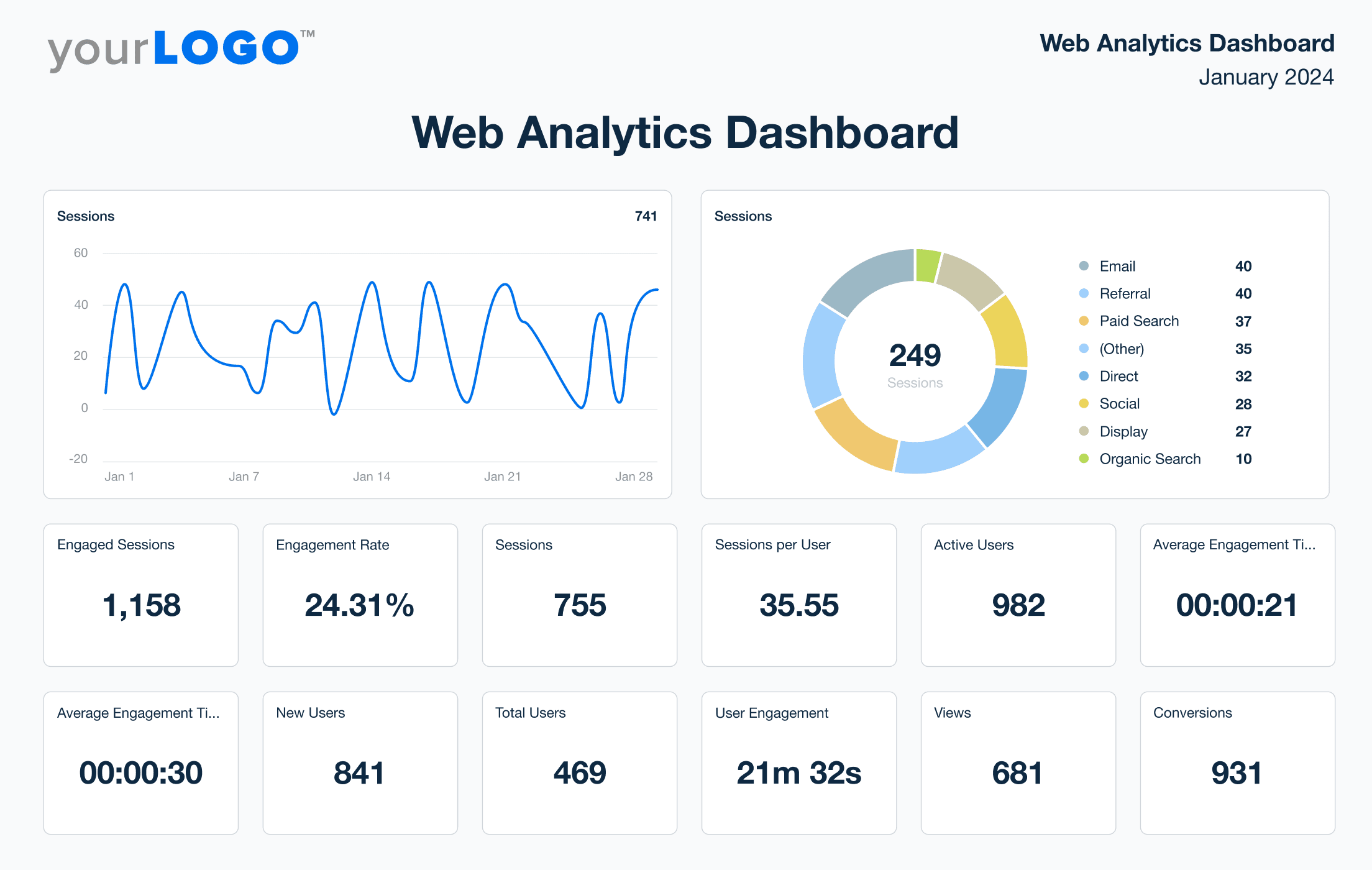
Need to identify and monitor important website KPIs for your clients? Set up a dashboard in AgencyAnalytics that consolidates data from Google Analytics, Semrush, Moz, and more. Try it free for 14 days!
Why Do Top Landing Pages Matter to Agencies?
For marketing agencies, top landing pages are important for understanding user intent and the success of entry points. These pages often contribute significantly to conversion rates, so knowing which pages perform best helps agencies refine their strategies and improve outcomes based on client goals.
12. Goal Completions
What Are Goal Completions?
Goal completions refer to the number of times users complete specific actions on a website that align with predefined objectives, such as making a purchase, filling out a contact form, or signing up for a newsletter. These actions are critical indicators of a website's success in achieving its intended outcomes.
How To Track Goal Completions
To track goal completions, use analytics tools like Google Analytics to set up goals based on a client’s key performance indicators. Once configured, the tool will automatically track and report the number of times users complete these defined actions, providing insights into the website's performance.
Why Do Goal Completions Matter to Agencies?
Marketing agencies track goal completions to understand a website’s overall performance. These metrics allow agencies to gauge how well the website meets business objectives and provide actionable data to optimize strategies and improve client ROI.
Read More: Top 19 Goal-Setting Frameworks to Consider for Agency and Client Goals
13. Bounce Rate
What Is Bounce Rate?
Bounce rate is the percentage of visitors who navigate away from a website after viewing only one page. It’s a key indicator of how well a website is engaging visitors and encouraging them to explore further.
How To Calculate Bounce Rate
Bounce rate is calculated using tools like Google Analytics 4. Agencies divide the total number of single-page sessions by the total number of entries to a page and then multiply by 100 to get a percentage.
For example, if a page had 1,000 entries and 400 single-page sessions, the bounce rate would be 40%.
To put this into perspective, the median bounce rate for websites is 45.9%.
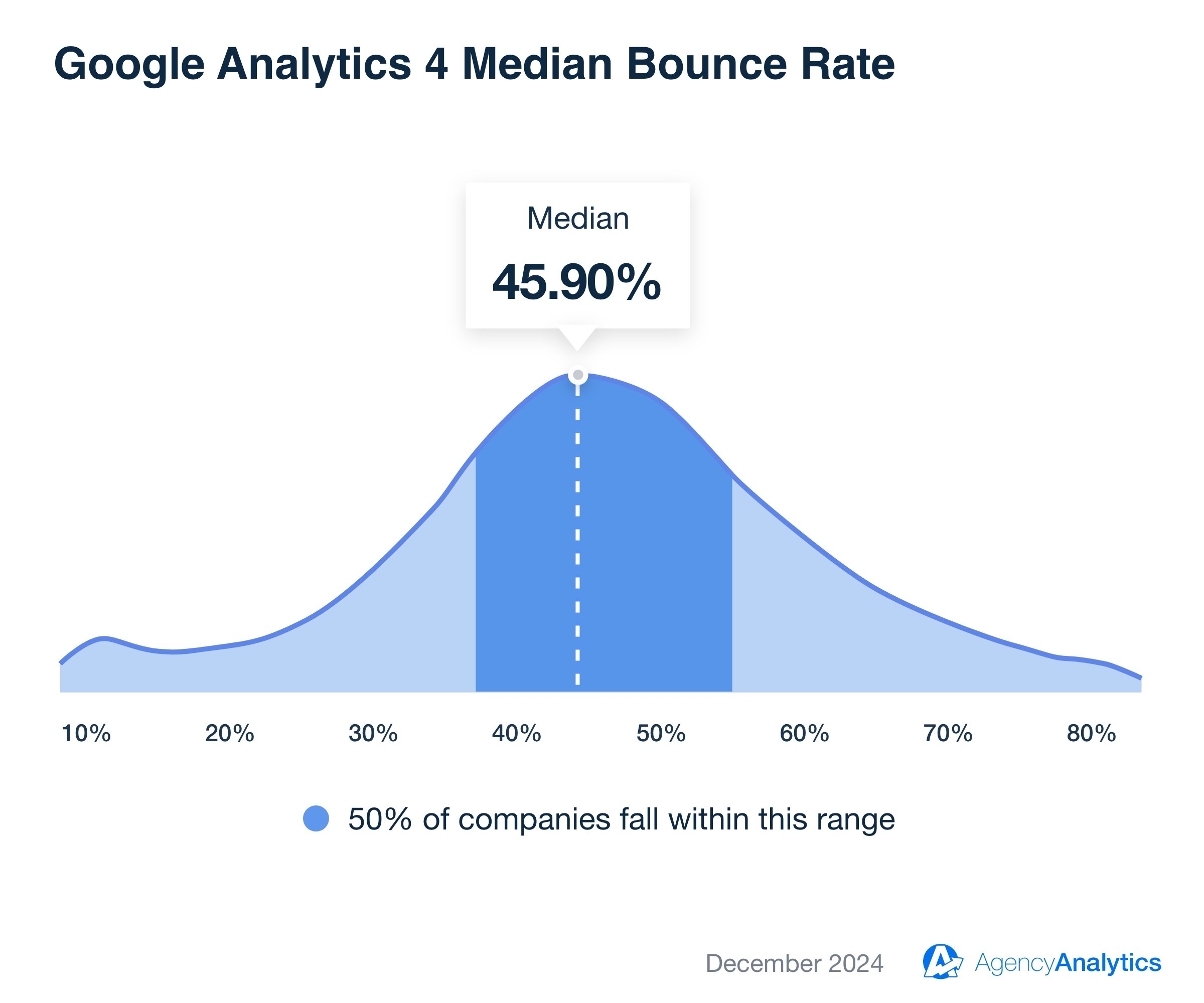
This based on the over 150,000 campaigns managed by 7,000+ who chose AgencyAnalytics as their client reporting partner.
Why Does Bounce Rate Matter to Agencies?
Bounce rate helps marketing agencies understand how well a client’s entire website or one of their specific pages is retaining visitors. A high bounce rate may signal that the page content or user experience needs improvement, while a lower rate indicates better engagement and alignment with visitor expectations.
14. Exit Rate
What Is Exit Rate?
Exit rate is the percentage of users who leave a website from a specific page, regardless of how many pages they visited before exiting. This metric helps identify which pages are most often the last ones viewed by visitors.
How To Calculate Exit Rate
Exit rate is calculated by dividing the number of exits from a specific page by the total number of page views for that page and then multiplying by 100 to get a percentage.
Here is an example: If a page had 500 views and 150 exits, the exit rate would be 30%.
Why Does Exit Rate Matter to Agencies?
Exit rate identifies potential issues with specific pages that may be causing users to leave. Agencies look at high exit rates on key pages to determine what content isn’t meeting user expectations or if there are any usability issues that need to be addressed to improve overall site performance.
15. Traffic by Source
What Is Traffic by Source?
Traffic by source refers to the origin of visitors coming to a website, whether it’s through organic search, paid ads, social media traffic, direct visits, or referral links. Understanding traffic sources provides insights into how users are finding a website.
How To Track Traffic by Source
To track Traffic by Source, use tools like Google Analytics to categorize traffic into different sources such as organic, direct, referral, and social.
Why Does Traffic by Source Matter to Agencies?
For marketing agencies, understanding traffic by source helps evaluate the effectiveness of each marketing channel. This information allows agencies to allocate resources more effectively, optimize campaigns, and identify which sources are contributing the most to the client's goals, whether that's traffic, conversions, or revenue.
16. Unique Website Visitors
What Are Unique Visitors?
Unique visitors represent the number of distinct users who visit a website over a specific period. Unlike total visits, which count the same person multiple times, Unique Visitors are only counted once, regardless of how many times they return to the site.
How To Track Unique Visitors
Agencies use Google Analytics to track unique visitors to identify and count individual users based on cookies or unique identifiers. This metric provides a clearer picture of the actual reach and audience size of a client’s website.
Why Do Unique Visitors Matter to Agencies?
This metric helps agencies evaluate the success of their efforts in attracting new users, and it’s essential for measuring the growth and reach of a website over time.
17. Sessions
What Are Sessions?
Sessions represent the total number of interactions a user has with a website within a specific time frame. A session starts when a user enters the site and includes all interactions until they leave or become inactive for a set period.
How To Track Sessions
Analytics tools record the duration and activity of each user’s visit to track sessions. A session may include a particular page or multiple page views, events, or transactions, giving a complete view of user engagement during their visit.
Why Do Sessions Matter to Agencies?
Increasing the number of sessions indicates that users are returning to the site, which suggests that the content or offerings are compelling and relevant. More sessions also have the potential to lead to higher conversion rates as users engage more deeply with the site, making it a key metric for long-term client success and retention. Agencies should consider tracking a variety of session metrics, including average session duration.
It's also important to understand what happens during these session, which is why average session duration is also important. To put this into perspective, the average session duration, based on proprietary benchmarks data, is 2 minutes and 19 seconds.

18. Referral Traffic
What Is Referral Traffic?
Referral traffic refers to visitors who land on a website by clicking a link from another site, rather than coming directly or through search engines. This web traffic helps measure the effectiveness of partnerships, content distribution, and external link-building efforts.
Influencer marketing has changed so much in the last few years, and a trackable ROI for most of our clients is traffic brought in via a UTM link or the number of times a code is redeemed.
Emily Carpenter, Director of Marketing, Digital Retail Partners
How To Track Referral Traffic
To track referral traffic, marketing teams categorize visitors based on the external sources that directed them to a client’s site. This data shows which external sites and content are driving traffic to the website.
Why Does Referral Traffic Matter to Agencies?
For marketing agencies, referral traffic is measured to evaluate the success of off-site marketing efforts, such as a guest blog post, influencer partnerships, and link-building strategies. An increase in Referral Traffic typically means that external content or partnerships are successfully driving users to the site, which often enhances brand visibility and leads to new business opportunities.
Read More: How To Create an Unstoppable Brand for Your Clients
How to Track Website KPIs With AgencyAnalytics
Marketing agencies use the AgencyAnalytics platform to track important website KPIs from a centralized location. With customizable dashboards, their teams (including their clients) monitor everything with up-to-date data in real-time.
By connecting key web analytics integrations like Google Analytics, agencies easily pair this data with PPC channels such as Google Ads, providing an in-depth understanding of where traffic is coming from and how it’s performing.
So, where do you begin? Start by logging into your AgencyAnalytics account and navigate to the client account you’d like to build a web analytics dashboard for. Then select “add” in the drop-down menu to create a new dashboard.
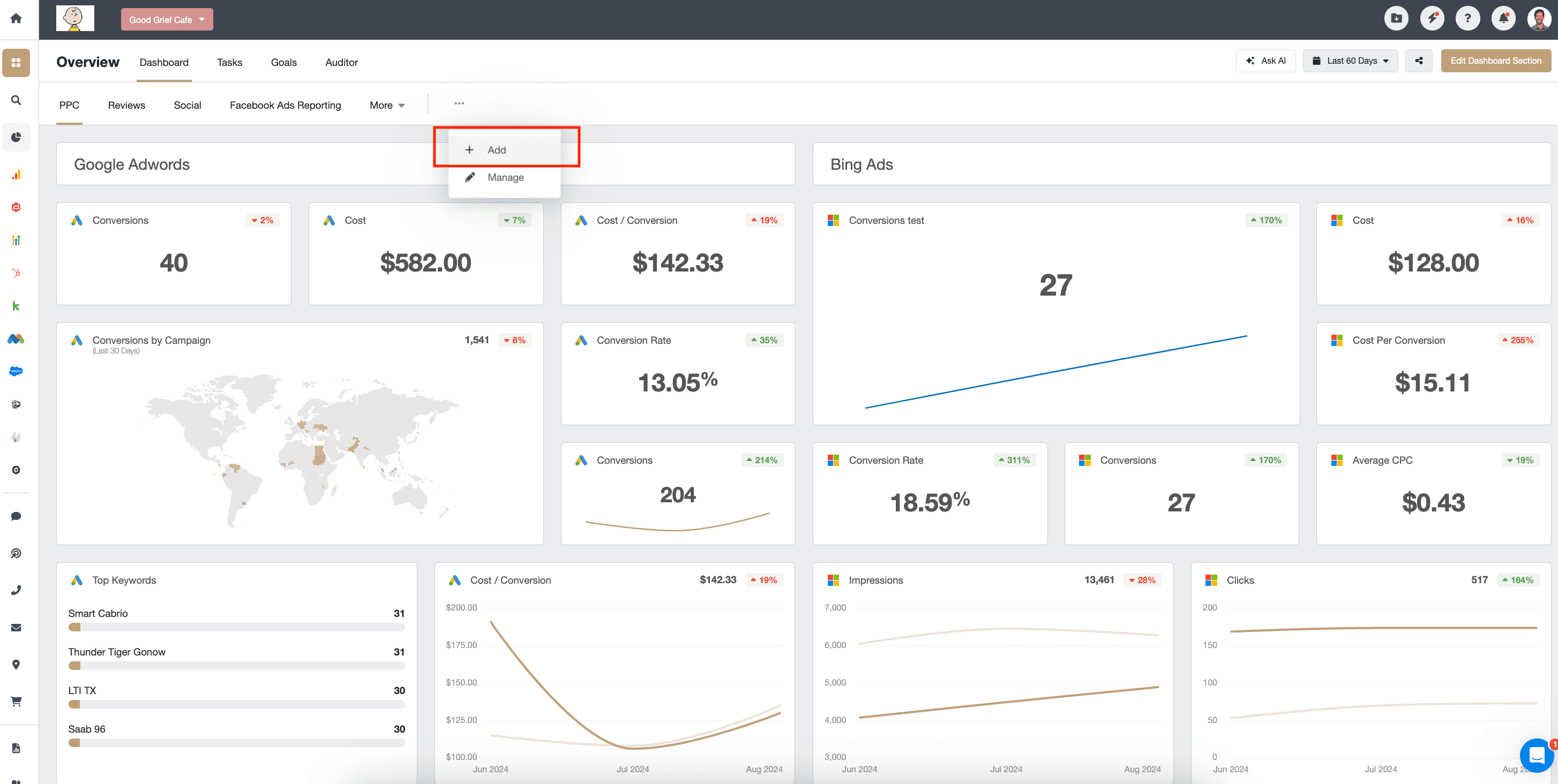
Next, you’ll be prompted to choose how you’d like to create the dashboard:
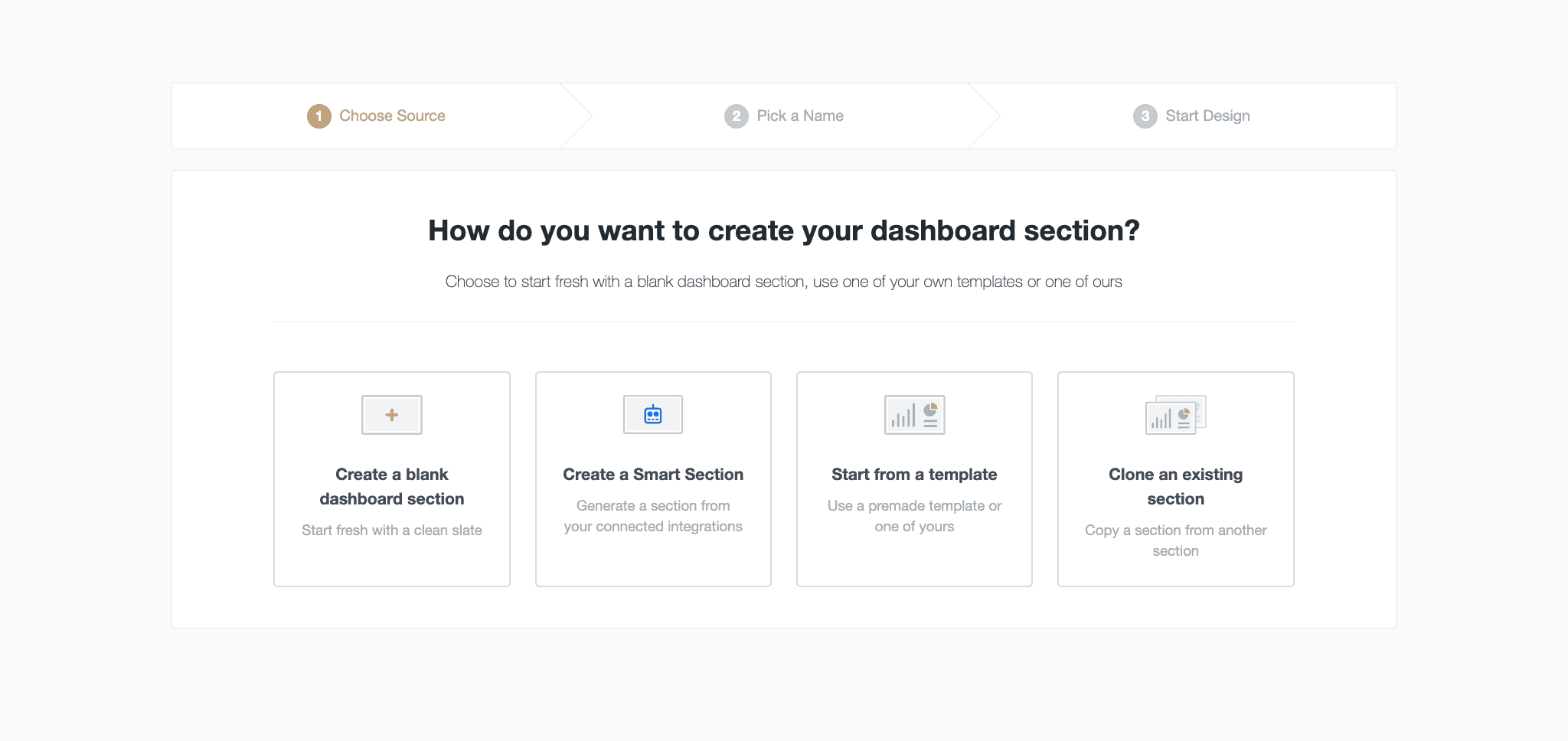
We’ve chosen to create a blank dashboard for this example. This allows you to drag and drop specific widgets you’d like from a variety of web analytics platforms.
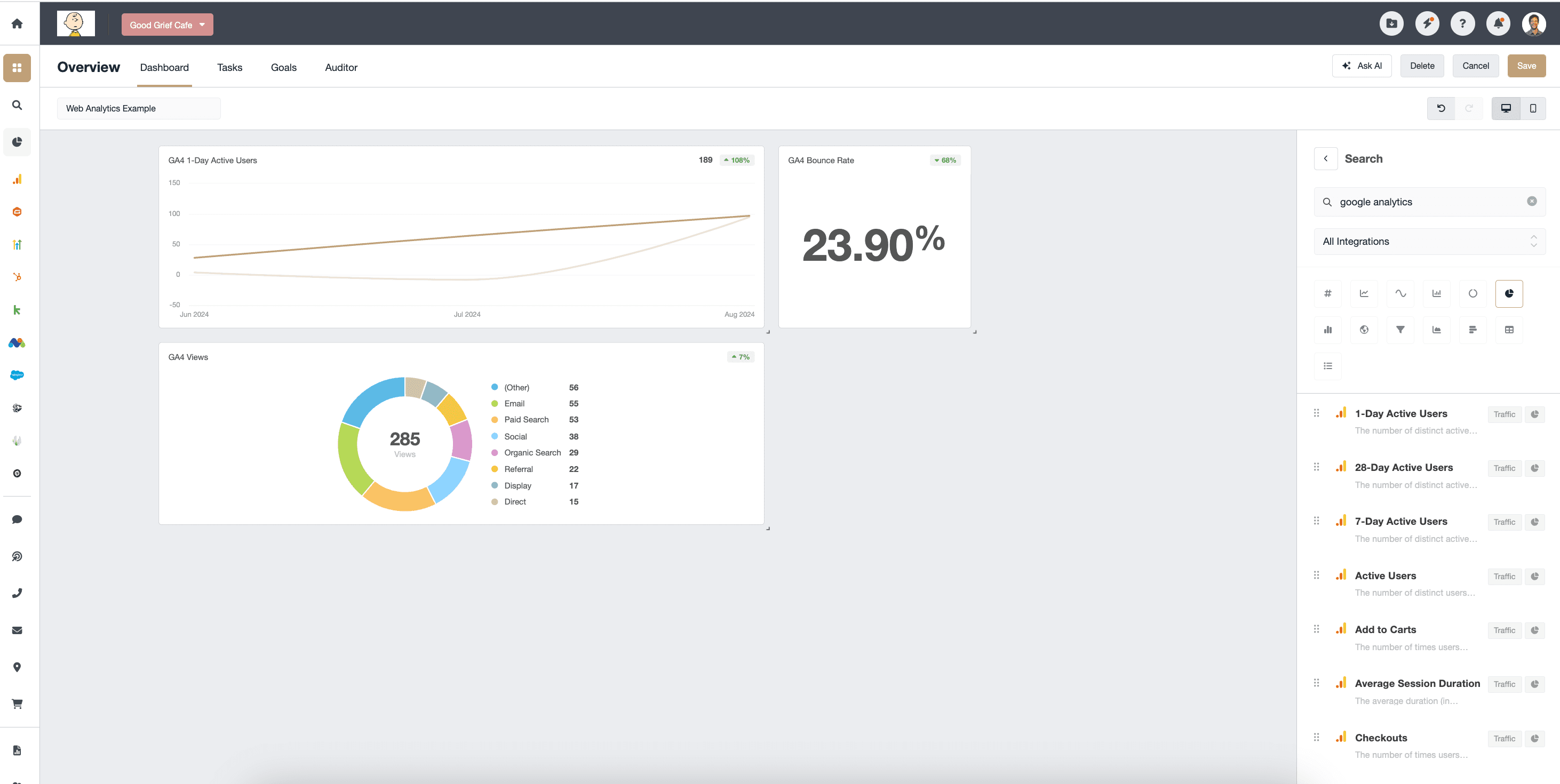
Under a time crunch? The Smart Reports and Smart Dashboards feature from AgencyAnalytics builds exactly what you need in 11 seconds or less. Try it out for yourself with a 14-day free trial.
With access to over 80 marketing channels, AgencyAnalytics gives agencies a complete picture of a client's marketing activity in one place. The platform’s user-friendly interface makes it easy to visualize data, identify trends, and make informed decisions, all while keeping clients in the loop with real-time insights. You can even use our web analytics report template to easily report on the right web KPI's to clients.
Whether tracking organic website traffic, conversions, or referral sources, AgencyAnalytics simplifies the entire process of managing and optimizing marketing strategies.
Summary & Key Takeaways
Tracking key website KPIs is just one piece of the marketing puzzle for agencies. However, it’s one of the best ways to measure and optimize the success of their clients' digital strategies.
Website KPIs are quantifiable indicators that reveal how well a website is achieving its business objectives. These metrics, such as bounce rate, goal completions, and traffic by source, provide key insights into user behavior, site performance, and the success of a marketing strategy.
AgencyAnalytics simplifies the process of tracking these KPIs by integrating data from various sources. Whether you need to monitor a wide range of KPIs—from exit rate and referral traffic to average time on page and customer acquisition cost (CAC)—it’s all in one, convenient place.
Here are some key takeaways for agencies to keep in mind when monitoring website KPIs:
Consistently monitor a diverse range of KPIs to gain a comprehensive view of website performance.
Use integrated tools like AgencyAnalytics to monitor performance metrics, streamline reporting, and improve data accuracy.
Focus on actionable insights that directly impact client success and ROI.
Need help getting started? Check out our help article on how to connect Google Analytics to your client’s dashboard. If you require more assistance, don’t hesitate to reach out to our world-class customer support team, available 24/5 with an average response rate of 3 minutes or less.

Written by
Richelle Peace is a writer with a degree in Journalism who focuses on web content, blog posts, and social media. She enjoys learning about different topics and sharing that knowledge with others. When she isn’t writing, Richelle spends time teaching yoga, where she combines mindfulness, movement, and her passion for wellness.
Read more posts by Richelle PeaceSee how 7,000+ marketing agencies help clients win
Free 14-day trial. No credit card required.



